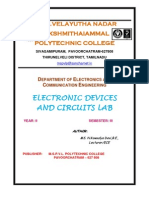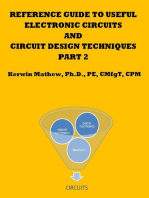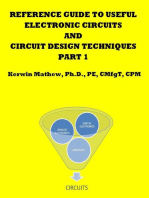Electronic Unit 1
Electronic Unit 1
Uploaded by
Sudheer ManepalliCopyright:
Available Formats
Electronic Unit 1
Electronic Unit 1
Uploaded by
Sudheer ManepalliOriginal Description:
Copyright
Available Formats
Share this document
Did you find this document useful?
Is this content inappropriate?
Copyright:
Available Formats
Electronic Unit 1
Electronic Unit 1
Uploaded by
Sudheer ManepalliCopyright:
Available Formats
Experiment No: …………….
1150EE302–Basic Electronics Laboratory 1
Date: ……. /……. /……………
Full Wave Rectifier With and Without Filter
Aim: To design and implement full wave rectifier with and without filter using
diode and draw its characteristics.
Equipment and Components Required:
S.NO NAME OF APPARATUS RANGE QUANTITY
DC Regulated Power
1. (0-30)V 1
Supply
2. Center Tap Transformer 230V/(12-0-12)V 1
3. Diode 1N4007 2
4. Capacitor 100μF 1
5. Resistor 1KΩ 1
6. CRO - 1
7. Bread board - 1
8. Connecting wires - As Required
Theory:
The circuit of a center-tapped full wave rectifier uses two diodes D1&D2. During
positive half cycle of secondary voltage (input voltage), the diode D1 is forward biased and
D2is reverse biased. The diode D1 conducts and current flows through load resistor RL.
During negative half cycle, diode D2 becomes forward biased and D1 reverse biased. Now,
D2 conducts and current flows through the load resistor RL in the same direction. There is a
continuous current flow through the load resistor RL, during both the half cycles and will
get unidirectional current as show in the model graph. The difference between full wave
and half wave rectification is that a full wave rectifier allows unidirectional (one-way)
VTU R 2015 Department of ECE , Veltech Dr.RR& Dr.SR University
1150EE302–Basic Electronics Laboratory 2
current to the load during the entire 360 degrees of the input signal and half-wave rectifier
allows this only during one-half cycle (180 degree).
PROCEDURE:
WITHOUT FILTER:
1. Give the connections as per the circuit diagram.
2. Give 230V, 50 HZ input to the step down transformer where the secondary is
connected to the rectifier input.
3. Take the rectifier output across the load.
4. Plot its performance graph.
WITH FILTER:
1. Give the connections as per the circuit diagram.
2. Give 230V, 50 HZ input to the step down transformer where the secondary is
connected to the rectifier input.
3. Connect the capacitor across the load.
4. Take the rectifier output across the load.
5. Plot its performance graph.
Observations :
Without Filter
𝑽𝒎
𝑽𝒓𝒎𝒔 = (1)
√𝟐
𝟐𝑽𝒎
𝑽𝒅𝒄 = (2)
𝝅
𝑹𝒊𝒑𝒑𝒍𝒆 𝑭𝒂𝒄𝒕𝒐𝒓 = √(𝑽𝒓𝒎𝒔 / 𝑽𝒅𝒄 )𝟐 − 𝟏 (3)
𝑬𝒇𝒇𝒊𝒄𝒊𝒆𝒏𝒄𝒚 = (𝑽𝒅𝒄 / 𝑽𝒓𝒎𝒔 )𝟐 ∗ 𝟏𝟎𝟎 (4)
VTU R 2015 Department of ECE , Veltech Dr.RR& Dr.SR University
1150EE302–Basic Electronics Laboratory 3
With Filter
𝑽𝒓𝒑𝒑
𝑽𝒓𝒎𝒔 = (1)
𝟐∗ √𝟑
𝑽𝒅𝒄 = 𝑽𝒎 − 𝑽𝒓𝒑𝒑 (2)
𝑽𝒓𝒎𝒔
𝑹𝒊𝒑𝒑𝒍𝒆 𝑭𝒂𝒄𝒕𝒐𝒓 = (3)
𝑽𝒅𝒄
Where
Vrms = RMS value of the voltage
Vdc =Average value of dc voltage
Vrpp = Ripple voltage
Vm = Maximum supply voltage
Vrms’ = RMS value of the ac component.
CIRCUIT DIAGRAM:
VTU R 2015 Department of ECE , Veltech Dr.RR& Dr.SR University
1150EE302–Basic Electronics Laboratory 4
TABULATION
WITHOUT FILTER
S.NO AMPLITUDE TIME PEROID
WITH FILTER
S.NO AMPLITUDE TIME PEROID
Tabulation to calculate the ripple factor and efficiency
WITHOUT FILTER
Vm Vrms Vdc Ripple Factor Efficiency
Vrms Vrpp Vdc Ripple Factor Efficiency
WITH FILTER
VTU R 2015 Department of ECE , Veltech Dr.RR& Dr.SR University
1150EE302–Basic Electronics Laboratory 5
Questions:
1. What is the PIV of Half wave rectifier?
2. What is the efficiency of half wave rectifier?
VTU R 2015 Department of ECE , Veltech Dr.RR& Dr.SR University
1150EE302–Basic Electronics Laboratory 6
3. What is the rectifier?
4. What is the difference between the half wave rectifier and full wave Rectifier?
5. What is the o/p frequency of Bridge Rectifier?
6. What are the ripples?
7. What is the function of the filters?
8. What is TUF?
9. What is the average value of o/p voltage for HWR?
VTU R 2015 Department of ECE , Veltech Dr.RR& Dr.SR University
1150EE302–Basic Electronics Laboratory 7
10. What is the peak factor?
Applications of Full Wave Rectifier:
The primary application of rectifiers is to derive DC power from an AC supply (AC to
DC converter). Virtually all electronic devices require DC, so rectifiers are used inside the
power supplies of virtually all electronic equipment.
Converting DC power from one voltage to another is much more complicated. One method of
DC-to-DC conversion first converts power to AC using a device called an inverter.
External Link
http://www.tpub.com/neets/ book6/22c.htm
Result:
……………………………………………………………………………………………….
VTU R 2015 Department of ECE , Veltech Dr.RR& Dr.SR University
1150EE302–Basic Electronics Laboratory 8
Experiment No: …………….
Date: ……. /……. /……………
Characteristics of Zener diode
Aim: To plot the forward and reverse characteristics of a Zener diode and find its
breakdown voltage.
Equipment and Components Required:
. S.NO NAME OF APPARATUS RANGE QUANTITY
1. DC Regulated Power Supply (0-30)V 1
(0-30)mA 1
2. Ammeter
(0-1000)μA 1
(0-1)V 1
3. Voltmeter
(0-30)V 1
4. Zener Diode B12PH 1
5. Resistor 1KΩ 1
6. Bread board - 1
As
7. Connecting wires -
Required
Theory:
A properly doped crystal diode, which has a sharp breakdown voltage, is known as zener
diode.
VTU R 2015 Department of ECE , Veltech Dr.RR& Dr.SR University
1150EE302–Basic Electronics Laboratory 9
FORWARD BIAS:
On forward biasing, initially no current flows due to barrier potential. As the applied
potential increases, it exceeds the barrier potential at one value and the charge carriers
gain sufficient energy to cross the potential barrier and enter the other region. The holes,
which are majority carriers in p-region, become minority carriers on entering the N-
regions and electrons, which are the majority carriers in the N-regions, become minority
carriers on entering the P-region. This injection of minority carriers results current,
opposite to the direction of electron movement.
REVERSE BIAS:
When the reverse bias is applied due to majority carriers small amount of current (i.e.)
reverse saturation current flows across the junction. As the reverse bias is increased to
breakdown voltage, sudden rise in current takes place due to zener effect.
ZENER EFFECT:
Normally, PN junction of Zener Diode is heavily doped. Due to heavy doping, the depletion
layer will be narrow. When the reverse bias is increased, the potential across the depletion
layer is more. This exerts a force on the electrons in the outermost shell. Because of this
force, the electrons are pulled away from the parent nuclei and become free electrons. This
ionization, which occurs due to electrostatic force of attraction, is known as Zener effect. It
results in large number of free carriers, which in turn increases the reverse saturation
current.
PROCEDURE:
FORWARD BIAS:
1. Connect the circuit as per the circuit diagram.
2. Vary the applied voltage V in steps of 0.1V till 30V.
3. Note down the corresponding ammeter readings I.
4. Plot the graph between V and I.
5. From the graph the forward dynamic Resistance of the diode is calculated
VTU R 2015 Department of ECE , Veltech Dr.RR& Dr.SR University
1150EE302–Basic Electronics Laboratory 10
REVERSE BIAS:
1. Connect the circuit as per the circuit diagram.
2. Vary the applied voltage V in steps of 0.1V till 30V.
3. Note down the corresponding ammeter readings I.
4. Plot the graph between V and I.
5. Find the dynamic resistance
6. Find the reverse breakdown voltage from the reverse characteristics curve.
CIRCUIT DIAGRAM:
FORWARD BIAS:
REVERSE BIAS:
VTU R 2015 Department of ECE , Veltech Dr.RR& Dr.SR University
1150EE302–Basic Electronics Laboratory 11
TABULATION:
FORWARD BIAS:
S.No FORWARD FORWARD
VIN
VOLTAGE VF (V) CURRENT IF (mA)
REVERSE BIAS:
VIN REVERSE VOLTAGE REVERSE
S.No
VR (V) CURRENT IR (uA)
VTU R 2015 Department of ECE , Veltech Dr.RR& Dr.SR University
1150EE302–Basic Electronics Laboratory 12
MODEL GRAPH:
VTU R 2015 Department of ECE , Veltech Dr.RR& Dr.SR University
1150EE302–Basic Electronics Laboratory 13
Advantages of zener diode
Power dissipation capacity is very high
High accuracy
Small size
Low cost
Applications of zener diode
It is normally used as voltage reference
Zener diodes are used in voltage stabilizers or shunt regulators.
Zener diodes are used in switching operations
Zener diodes are used in clipping and clamping circuits.
Zener diodes are used in various protection circuits
External Link:
http://www.physics-and-radio-electronics.com/electronic-devices-and-
circuits/semiconductor-diodes/zenerdiode-definition-vicharacteristics-
breakdowns.html
Result:
……………………………………………………………………………………………………………………………………
VTU R 2015 Department of ECE , Veltech Dr.RR& Dr.SR University
1150EE302–Basic Electronics Laboratory 14
Questions:
1. Draw the ideal characteristics of P-N junction diode?
2. What is the diode equation?
3. What is PIV?
4. What is the break down voltage?
5. What is the effect of temperature on PN junction diodes?
6. In which region zener diode can be used as a regulator.
7. How the breakdown voltage of a particular diode can be controlled?
8. By what type of charge carriers the current flows in zener and avalanche breakdown
diodes.
VTU R 2015 Department of ECE , Veltech Dr.RR& Dr.SR University
1150EE302–Basic Electronics Laboratory 15
Experiment No: …………….
Date: ……. /……. /……………
Bandwidth study of CE Amplifier
Aim: To study and plot the frequency response and band width of CE amplifier with fixed
bias.
Equipment and Components Required:
S.NO Equipment /Component Range Quantity
. 1 CRO 0-30MHz 1
2 Regulated Power Supply (0-30)V 1
3 Signal Generator (0-3 )MHz 1
4 Transistor BC 107 1
5 56KΩ, 4.7KΩ,1KΩ,10
Resistors Each 1
KΩ
6 Capacitors 0.1 µF,10 µF 2,1
7 Bread Board - 1
8 Connecting wires, probes - As per required
Theory:
Amplifiers is a simple block containing the amplifying device, such as a transistor which
has two input terminals and two output terminals (ground being common) with the output
signal being much greater than that of the input signal as it has been “Amplified”.
Generally, an ideal signal amplifier has three main properties, Input
Resistance or ( Rin ), Output Resistance or ( Rout ) and of course amplification known
commonly as Gain or ( A ). No matter how complicated an amplifier circuit is, a general
amplifier model can still be used to show the relationship of these three properties.
VTU R 2015 Department of ECE , Veltech Dr.RR& Dr.SR University
1150EE302–Basic Electronics Laboratory 16
Ideal Amplifier Model
The difference between the input and output signals is known as the Gain of the amplifier
and is basically a measure of how much an amplifier “amplifies” the input signal. For
example, if we have an input signal of 1 volt and an output of 50 volts, then the gain of the
amplifier would be “50”. In other words, the input signal has been increased by a factor of
50. This increase is called Gain.
Amplifier gain is simply the ratio of the output divided-by the input. Gain has no units as its
a ratio, but in Electronics it is commonly given the symbol “A”, for Amplification. Then the
gain of an amplifier is simply calculated as the “output signal divided by the input signal”.
Amplifier Gain
The introduction to the amplifier gain can be said to be the relationship that exists between
the signal measured at the output with the signal measured at the input. There are three
different kinds of amplifier gain which can be measured and these are: Voltage
Gain ( Av ), Current Gain ( Ai ) and Power Gain ( Ap ) depending upon the quantity being
measured with examples of these different types of gains are given below.
Amplifier Gain of the Input Signal
𝒐𝒖𝒕𝒑𝒖𝒕 𝒗𝒐𝒍𝒕𝒂𝒈𝒆 𝑽𝒐𝒖𝒕
Voltage Amplifier Gain , 𝑨𝒗 = =
𝒊𝒏𝒑𝒖𝒕 𝒗𝒐𝒍𝒕𝒂𝒈𝒆 𝑽𝒊𝒏
𝑶𝒖𝒕𝒑𝒖𝒕 𝑪𝒖𝒓𝒓𝒆𝒏𝒕 𝑰𝒐𝒖𝒕
Current Amplifier Gain , 𝑨𝒊 = =
𝑰𝒏𝒑𝒖𝒕 𝑪𝒖𝒓𝒓𝒆𝒏𝒕 𝑰𝒊𝒏
The Bel (B) is a logarithmic unit (base 10) of measurement that has no units. Since the Bel
is too large a unit of measure, it is prefixed with deci making it Decibels instead with one
VTU R 2015 Department of ECE , Veltech Dr.RR& Dr.SR University
1150EE302–Basic Electronics Laboratory 17
decibel being one tenth (1/10th) of a Bel. To calculate the gain of the amplifier in Decibels
or dB, we can use the following expressions.
Voltage Gain in dB: av = 20 log Av
Current Gain in dB: ai = 20 log Ai
Power Gain in dB: ap = 10 log Ap
Note that the DC power gain of an amplifier is equal to ten times the common log of the
output to input ratio, where as voltage and current gains are 20 times the common log of
the ratio. Note however, that 20dB is not twice as much power as 10dB because of the log
scale.
Also, a positive value of dB represents a Gain and a negative value of dB represents
a Loss within the amplifier. For example, an amplifier gain of +3dB indicates that the
amplifiers output signal has “doubled”, (x2) while an amplifier gain of -3dB indicates that
the signal has “halved”, (x0.5) or in other words a loss.
The -3dB point of an amplifier is called the half-power point which is -3dB down from
maximum, taking 0dB as the maximum output value.
Operation of CE Amplifier
When a signal is applied across the emitter-base junction, the forward bias across
this junction increases during the upper half cycle. This leads to increase the flow of
electrons from the emitter to a collector through the base, hence increases the collector
current. The increasing collector current makes more voltage drops across the collector
load resistor RC. The negative half cycle decreases the forward bias voltage across the
emitter-base junction. The decreasing collector-base voltage decreases the collector
current in the whole collector resistor Rc. Thus, the amplified load resistor appears across
the collector resistor.
VTU R 2015 Department of ECE , Veltech Dr.RR& Dr.SR University
1150EE302–Basic Electronics Laboratory 18
PROCEDURE:
1. Connect the circuit as per the circuit diagram.
2. Put input voltage as at a constant voltage being signal generator.
3. Keeping the input voltage constant, vary the frequency from 1 HZ to 1 MHZ
corresponding output voltage is noted
4. Plot the frequency response by varying the input frequency and note down the
output voltage.
5. Calculate the gain from the formula Gain=20 log [Vout / Vin ]dB.
6. Plot the following characteristics and obtain bandwidth.
Bandwidth=F2-F1.
Symbol of Transistor
VTU R 2015 Department of ECE , Veltech Dr.RR& Dr.SR University
1150EE302–Basic Electronics Laboratory 19
CIRCUIT DIAGRAM
Figure 1. Common Emitter Amplifier
CE Amplifier Frequency Response
The voltage gain of a CE amplifier varies with signal frequency. It is because reactances of
the capacitors in the circuit changes with signal frequency and hence affects the output
voltage. The curve drawn between voltage gain and the signal frequency of an amplifier is
known as frequency response. Below figure shows the frequency response of a typical CE
amplifier.
VTU R 2015 Department of ECE , Veltech Dr.RR& Dr.SR University
1150EE302–Basic Electronics Laboratory 20
Figure 2. Bandwidth of CE Amplifier
From the above graph, we observe that the voltage gain drops off at low (< FL) and high
(> FH) frequencies, whereas it is constant over the mid-frequency range (FL to FH).
TABULATION :
VIN = V
S.No Frequency (Hz) Output voltage (Vo) in v Gain (dB)
VTU R 2015 Department of ECE , Veltech Dr.RR& Dr.SR University
1150EE302–Basic Electronics Laboratory 21
Applications of CE Amplifier
The common emitter circuit is popular because it’s well-suited for voltage amplification,
especially at low frequencies.
Common-emitter amplifiers are also used in radio frequency transceiver circuits.
Common emitter configuration commonly used in low-noise amplifiers.
External Link:
https://www.elprocus.com/common-emitter-amplifier-ce-circuit-working-
applications/
Conclusion:
……………………………………………………………………………………………………………………………………
VTU R 2015 Department of ECE , Veltech Dr.RR& Dr.SR University
1150EE302–Basic Electronics Laboratory 22
QUESTIONS
1. What is the equation for voltage gain?
2. What is cut off frequency? What is lower 3dB and upper 3dB cut off frequency?
3. What are the applications of CE amplifier?
4. What is active region?
5. What is Bandwidth of an amplifier?
VTU R 2015 Department of ECE , Veltech Dr.RR& Dr.SR University
1150EE302–Basic Electronics Laboratory 23
Experiment No: …………….
Date: ……. /……. /……………
Realization of Adders
Aim: To design half adder and full adder circuits and verify it using the truth
table.
Equipment and Components Required:
Sl.No. COMPONENT SPECIFICATION QTY.
.
1. AND GATE IC 7408 1
2. X-OR GATE IC 7486 1
3. OR GATE IC 7432 1
4. IC TRAINER KIT - 1
5. PATCH CORDS - few
Theory:
HALF ADDER:
A half adder has two inputs for the two bits to be added and two outputs one from
the sum ‘ S’ and other from the carry ‘ c’ into the higher adder position. Above circuit is
called as a carry signal from the addition of the less significant bits sum from the X-OR Gate
the carry out from the AND gate.
VTU R 2015 Department of ECE , Veltech Dr.RR& Dr.SR University
1150EE302–Basic Electronics Laboratory 24
FULL ADDER:
A full adder is a combinational circuit that forms the arithmetic sum of input; it consists of
three inputs and two outputs. A full adder is useful to add three bits at a time but a half
adder cannot do so. In full adder sum output will be taken from X-OR Gate, carry output
will be taken from OR Gate.
LOGIC DIAGRAM:
HALF ADDER
TRUTH TABLE:
A B CARRY SUM
0 0 0 0
0 1 0 1
1 0 0 1
1 1 1 0
VTU R 2015 Department of ECE , Veltech Dr.RR& Dr.SR University
1150EE302–Basic Electronics Laboratory 25
LOGIC DIAGRAM:
FULL ADDER
FULL ADDER USING TWO HALF ADDER
TRUTH TABLE:
A B C CARRY SUM
0 0 0 0 0
0 0 1 0 1
0 1 0 0 1
0 1 1 1 0
1 0 0 0 1
1 0 1 1 0
1 1 0 1 0
1 1 1 1 1
VTU R 2015 Department of ECE , Veltech Dr.RR& Dr.SR University
1150EE302–Basic Electronics Laboratory 26
PROCEDURE:
1. Connections are given as per circuit diagram.
2. Logical inputs are given as per circuit diagram.
3. Observe the output and verify the truth table.
Applications of Adders:
There are many applications of Half Adder and Full Adder .These circuits are
actually basic building of any digital electronics device. The half-adder is useful
when you want to add one binary digit quantities. To add two bits no. in computer
chip half adder is use. They are integrated in the calculators.
Used in Processor, and ALU (arithmetic logic circuitry)
External link:
http://www.sanfoundry.com/digital-circuits-questions-answers-half-adder-full-adder/
QUESTIONS:
1. In parts of the processor, adders are used to calculate
a) Addresses
b) Table indices
c) Increment and decrement operators
d) All of the Mentioned
VTU R 2015 Department of ECE , Veltech Dr.RR& Dr.SR University
1150EE302–Basic Electronics Laboratory 27
2. Total number of inputs in a half adder is
a) 2
b) 3
c) 4
d) 1
3. In which operation carry is obtained?
a) Subtraction
b) Addition
c) Multiplication
d) Both addition and subtraction
4. If A and B are the inputs of a half adder, the sum is given by
a) A AND B
b) A OR B
c) A XOR B
d) A EXOR B
5. If A and B are the inputs of a half adder, the carry is given by
a) A AND B
b) A OR B
c) A XOR B
d) A EXOR B
6. Half-adders have a major limitation in that they cannot
a) Accept a carry bit from a present stage
b) Accept a carry bit from a next stage
c) Accept a carry bit from a previous stage
d) None of the Mentioned
7. The difference between half adder and full adder is
a) Half adder has two inputs while full adder has four inputs
b) Half adder has one output while full adder has two outputs
VTU R 2015 Department of ECE , Veltech Dr.RR& Dr.SR University
1150EE302–Basic Electronics Laboratory 28
c) Half adder has two inputs while full adder has three inputs
d) All of the Mentioned
8. If A, B and C are the inputs of a full adder then the sum is given by
a) A AND B AND C
b) A OR B AND C
c) A OR B OR C
d) A XOR B XOR C
RESULT:
VTU R 2015 Department of ECE , Veltech Dr.RR& Dr.SR University
1150EE302–Basic Electronics Laboratory 29
Experiment No: …………….
Date: ……. /……. /……………
Solar Light Activated Switch
Aim: To design a circuit using solar panel and to activate it as a switch.
Equipment and Components Required:
.
Sl.No. COMPONENT SPECIFICATION QTY.
1 Solar panel 6V/100mA 1
2 Resistors 10 Ω 1
3 LED - 1
4 RPS (0-30) v 1
5 Connecting wires - -
Theory:
Solar panels are devices that convert light into electricity. They are called "solar"
panels because most of the time, the most powerful source of light available is the Sun,
called Sol by astronomers. Some scientists call them photovoltaics which means, basically,
"light-electricity." A solar panel is a collection of solar cells. Lots of small solar cells spread
over a large area can work together to provide enough power to be useful. The more light
that hits a cell, the more electricity it produces, so spacecraft are usually designed with
solar panels that can always be pointed at the Sun even as the rest of the body of the
spacecraft moves around, much as a tank turret can be aimed independently of where the
tank is going.
VTU R 2015 Department of ECE , Veltech Dr.RR& Dr.SR University
1150EE302–Basic Electronics Laboratory 30
CIRCUIT DIAGRAM:
PROCEDURE:
SWITCH ON CONDITION:
1. Give connections are given as per circuit diagram.
2. Expose solar panel in sun light.
3. The output from the solar panel triggers the SCR as Gate current.
4. SCR fires and LED will glow.
SWITCH OFF CONDITION:
1. Give connections are given as per circuit diagram.
2. Do not expose solar panel in sun light.
3. Now the output from the solar panel will not trigger the SCR and LED will not glow.
4. Thus Solar Panel is activated as a switch
VTU R 2015 Department of ECE , Veltech Dr.RR& Dr.SR University
1150EE302–Basic Electronics Laboratory 31
Light Activated Switch Circuit Applications:
This circuit can be used in security applications like when there is darkness on the
LDR, it stops lighting.
This can be used in applications where the light is switched on /off depending on the
ambient light
Questions:
1. What is the material used for the fabrication of solar panel?
2. Solar panel – Transducer or sensor?
3. What is a transducer?
4. What is difference between transducer and sensor?
5. Give the examples of transducers and sensor?
RESULT:
___________________________________________________________________________________
VTU R 2015 Department of ECE , Veltech Dr.RR& Dr.SR University
1150EE302–Basic Electronics Laboratory 32
Experiment No: …………….
Date: ……. /……. /……………
Measurement of Electromagnetic Interference
Aim: To measure the electromagnetic interference (EMI) created due to electronic devices.
Equipment and Components Required:
. Sl.No. COMPONENT QTY.
1 Micro Phone 1
2 Mobile phone 1
3 Personal Computer 1
4 FM Radio 1
5 Electro smog meter 1
Theory:
Electromagnetic interference (EMI), also called radio-frequency interference (RFI)
when in the radio frequency spectrum, is a disturbance generated by an external source
that affects an electrical circuit by electromagnetic induction, electrostatic coupling, or
conduction. The disturbance may degrade the performance of the circuit or even stop it
from functioning. In the case of a data path, these effects can range from an increase in
error rate to a total loss of the data. Both man-made and natural sources generate changing
electrical currents and voltages that can cause EMI: automobile ignition systems, cell
phones, thunder storms, the Sun, and the Northern Lights. EMI frequently affects AM
radios. It can also affect cell phones, FM radios, and televisions.
EMI can be used intentionally for radio jamming, as in electronic warfare.
VTU R 2015 Department of ECE , Veltech Dr.RR& Dr.SR University
1150EE302–Basic Electronics Laboratory 33
Electromagnetic interference can be categorized as follows:
Narrowband EMI or RFI interference typically emanates from intended
transmissions, such as radio and TV stations or cell phones. Broadband EMI or RFI
interference is unintentional radiation from sources such as electric power
transmission lines. Conducted electromagnetic interference is caused by the physical
contact of the conductors as opposed to radiated EMI, which is caused by induction
(without physical contact of the conductors). Electromagnetic disturbances in the EM field
of a conductor will no longer be confined to the surface of the conductor and will radiate
away from it. This persists in all conductors and mutual inductance between two radiated
electromagnetic fields will result in EMI.
BLOCK DIAGRAM:
Input Device Output Device
Channel(Air)
(Micro phone)
Interference
Device
TABULAR COLUMN:
S.NO NAME OF THE FREQUENCY FREQUENCY VALUE
DEVICE VALUE (WITHOUT (WITH
INTERFERENCE) INTERFERENCE)
1.
2.
3.
VTU R 2015 Department of ECE , Veltech Dr.RR& Dr.SR University
1150EE302–Basic Electronics Laboratory 34
PROCEDURE:
1. Make the arrangements as per the block diagram.
2. Note down the frequency value before giving the interference.
3. Introduce the interference between input and output device.
4. Note down the frequency value using the measurement device.
5. Measure the interference value and note down the values for different interference
devices.
Applications of EMI Measurements
Antenna Analysis Broadband antennas such as biconical antennas, log periodic antennas,
loop antennas and horns are typically used in EMC test setups. These antennas can be
analysed efficiently in FEKO using the method of moments (MoM) solver for which only the
surfaces of conductors and dielectrics are discretised.
External link:
http://www.completepowerelectronics.com/emi-emc-tutorial/
VTU R 2015 Department of ECE , Veltech Dr.RR& Dr.SR University
1150EE302–Basic Electronics Laboratory 35
Questions :
1. What is EMI & EMC?
2. Define SAR.
3. Write down the minimum value of SAR?
RESULT
________________________________________________________________________________
VTU R 2015 Department of ECE , Veltech Dr.RR& Dr.SR University
You might also like
- EPC BEC303 List of ExpsDocument51 pagesEPC BEC303 List of Expskaranphutane2254No ratings yet
- Eickhoff Gearbox Operating ManualDocument83 pagesEickhoff Gearbox Operating Manualjjohnsco100% (5)
- Electronic Principles and Circuits Lab Manual - BEC303 - 18-11-2023Document69 pagesElectronic Principles and Circuits Lab Manual - BEC303 - 18-11-2023Maithira H50% (2)
- Jian Ghomeshi Sex Assault Trial Closing SubmissionsDocument88 pagesJian Ghomeshi Sex Assault Trial Closing SubmissionsNational Post67% (3)
- Atwood Poem - ButterflyDocument2 pagesAtwood Poem - ButterflypaoNo ratings yet
- Lab File Basics of Electronics & Electrical Engg. (For PTU B.Tech. 1st Year)Document49 pagesLab File Basics of Electronics & Electrical Engg. (For PTU B.Tech. 1st Year)Cutie33% (3)
- Thesis 111Document74 pagesThesis 111Mubashir SheheryarNo ratings yet
- Beee Lab Manual (Ec)Document33 pagesBeee Lab Manual (Ec)PIYUSH KUMARNo ratings yet
- DEVICE EXP 2 Student - 2Document4 pagesDEVICE EXP 2 Student - 2Pablo ChanNo ratings yet
- IPCC EPC Lab Manual-2023 - 231117 - 094512 (1) - 231120 - 121052Document79 pagesIPCC EPC Lab Manual-2023 - 231117 - 094512 (1) - 231120 - 121052Pratheeksha MuraliNo ratings yet
- Lab 04Document10 pagesLab 0449 - 103 - Umair HossainNo ratings yet
- EEE111 - Lab ManualDocument28 pagesEEE111 - Lab ManualAnindita MishiNo ratings yet
- AE Lab Manual For EeeDocument53 pagesAE Lab Manual For EeeSRUJANA VNo ratings yet
- Device Exp 2 Student ManualDocument4 pagesDevice Exp 2 Student Manualgg ezNo ratings yet
- Pe Lab ManualDocument53 pagesPe Lab ManualKada JashNo ratings yet
- Half Wave RectifierDocument6 pagesHalf Wave RectifierVARAPRASADNo ratings yet
- ED Lab Experiment Manual 2Document6 pagesED Lab Experiment Manual 2mrcox17324No ratings yet
- Sdc-Labmanual by Prabhu Kumar SurarapuDocument62 pagesSdc-Labmanual by Prabhu Kumar Surarapuprabhu4scribdNo ratings yet
- EDC LAB ManualDocument142 pagesEDC LAB Manualsangeethasiva75% (4)
- Lab Manual 3 Semester Basic Electronics - I: Lab Engineerer: Subject TeacherDocument21 pagesLab Manual 3 Semester Basic Electronics - I: Lab Engineerer: Subject TeacherOmer Sheikh100% (1)
- Aust/Eee: Ahsanullah University of Science and TechnologyDocument27 pagesAust/Eee: Ahsanullah University of Science and TechnologyShariful IslamNo ratings yet
- Power ElectronicsDocument83 pagesPower ElectronicsSreekanth SurendrenNo ratings yet
- EXP NO-3Document8 pagesEXP NO-3Er.Utpal Kumar PaulNo ratings yet
- Electronics Devices & Circuit Lab ManualDocument53 pagesElectronics Devices & Circuit Lab Manualbiswajit7sarkar100% (1)
- Exp No 1 - FWR, Vtu17455 PDFDocument9 pagesExp No 1 - FWR, Vtu17455 PDFAnudeep ThanikondaNo ratings yet
- Analog CircuitsDocument32 pagesAnalog CircuitstsangwanNo ratings yet
- EXP NO-1Document7 pagesEXP NO-1Er.Utpal Kumar PaulNo ratings yet
- Electronic Components Circuits: (Diode Characteristies - Rectifier - Clipper)Document14 pagesElectronic Components Circuits: (Diode Characteristies - Rectifier - Clipper)em2200139No ratings yet
- Full Wave RectifierDocument7 pagesFull Wave RectifierVARAPRASADNo ratings yet
- Eee 111 Lab Manual 2-8 (Latest)Document32 pagesEee 111 Lab Manual 2-8 (Latest)Ismot Jahan MoniNo ratings yet
- 10.fullwave RectifierDocument3 pages10.fullwave RectifierSUMITH K SNo ratings yet
- Lab2 Report 1620660042Document21 pagesLab2 Report 1620660042Nafiz SheikhNo ratings yet
- AEC Manual 2018-2019Document99 pagesAEC Manual 2018-2019Raza SikandarNo ratings yet
- O.C & S.C Test On Single Phase Transformer.: Siddhartha Institute of Engineering & TechnologyDocument6 pagesO.C & S.C Test On Single Phase Transformer.: Siddhartha Institute of Engineering & Technologyal imranNo ratings yet
- Physics Project On Half Wave RectifierDocument15 pagesPhysics Project On Half Wave RectifierMaanu Style100% (7)
- Electronics Lab 2019Document37 pagesElectronics Lab 2019Noor HussainNo ratings yet
- Electronic Devices & Circuits: Laboratory ManualDocument61 pagesElectronic Devices & Circuits: Laboratory ManualFadila IsmailNo ratings yet
- Electronic Device Lab Report 2Document11 pagesElectronic Device Lab Report 2smfahim1919No ratings yet
- AE Lab Report 3Document6 pagesAE Lab Report 3punjabians626621No ratings yet
- Electronics Device Circuit Lab SheetDocument27 pagesElectronics Device Circuit Lab Sheetjimfinch512No ratings yet
- شيت مختبر الكترونيك القدرة 2 PDFDocument21 pagesشيت مختبر الكترونيك القدرة 2 PDFMustafa MhmoodNo ratings yet
- PE Lab 2 ReportDocument15 pagesPE Lab 2 ReportMaryamNo ratings yet
- 18-Full Wave Rectifier With Filter and Regulator+earth Resistance Measurement-20-12-2022Document5 pages18-Full Wave Rectifier With Filter and Regulator+earth Resistance Measurement-20-12-2022Zack ZackNo ratings yet
- 3rd Semester Lab 201Document36 pages3rd Semester Lab 201Noor HussainNo ratings yet
- 3rd Semester Lab 2019Document36 pages3rd Semester Lab 2019Noor HussainNo ratings yet
- Semiconductor Devices and Circuit Lab ManualDocument46 pagesSemiconductor Devices and Circuit Lab ManualManu anand100% (1)
- Exp 2 Study of Half Wave and Full Wave Diode RectifiersDocument9 pagesExp 2 Study of Half Wave and Full Wave Diode Rectifiersbob nayadNo ratings yet
- Experiment - 4 Half Wave Rectifier Pre - Lab QuestionsDocument8 pagesExperiment - 4 Half Wave Rectifier Pre - Lab Questionsgautam KrishnaNo ratings yet
- Power Electronics ManualDocument42 pagesPower Electronics ManualJavaria Chiragh50% (2)
- BASIC ELECTRONICS LAB4Document17 pagesBASIC ELECTRONICS LAB4Muhammad HamzaNo ratings yet
- 12025Document18 pages12025Zachary HuffmanNo ratings yet
- N. Bacalso Avenue, Cebu City: Cebu Institute of Technology - UniversityDocument15 pagesN. Bacalso Avenue, Cebu City: Cebu Institute of Technology - UniversityTreyes RobertNo ratings yet
- Half Wave Rectifier and Full Wave RectifierDocument5 pagesHalf Wave Rectifier and Full Wave RectifierAdvyth Vaman AkalankamNo ratings yet
- Full Wave Rectifier ManualDocument6 pagesFull Wave Rectifier ManualGOURAV KUMARNo ratings yet
- Half Wave Rectifier and Full Wave RectifierDocument4 pagesHalf Wave Rectifier and Full Wave Rectifierjosephmathewt98No ratings yet
- Electronics LADocument128 pagesElectronics LAGnanaselvakumar ANo ratings yet
- 1040233320 -EDC manual-finalDocument56 pages1040233320 -EDC manual-finalVINOTH KUMARNo ratings yet
- WARKDocument8 pagesWARKkencaroline447No ratings yet
- Reference Guide To Useful Electronic Circuits And Circuit Design Techniques - Part 2From EverandReference Guide To Useful Electronic Circuits And Circuit Design Techniques - Part 2No ratings yet
- Reference Guide To Useful Electronic Circuits And Circuit Design Techniques - Part 1From EverandReference Guide To Useful Electronic Circuits And Circuit Design Techniques - Part 1Rating: 2.5 out of 5 stars2.5/5 (3)
- Design of Electrical Circuits using Engineering Software ToolsFrom EverandDesign of Electrical Circuits using Engineering Software ToolsNo ratings yet
- Valle Verde Country Club, Inc. v. Africa G.R. No.151969, September 4, 2009Document10 pagesValle Verde Country Club, Inc. v. Africa G.R. No.151969, September 4, 2009Jerwin Cases TiamsonNo ratings yet
- Mid - Term Examination in Methods of ResearchDocument3 pagesMid - Term Examination in Methods of ResearchLala Belles GusiNo ratings yet
- (10!02!21) Principles of EconomicsDocument2 pages(10!02!21) Principles of EconomicsKarthika S. BabuNo ratings yet
- The Jewish Targums and John's Logos TheologyDocument3 pagesThe Jewish Targums and John's Logos TheologyJim WestNo ratings yet
- 1-Reading Strategies (Remembering Cathy)Document2 pages1-Reading Strategies (Remembering Cathy)ENRICO SANORIA PALER, M.A.No ratings yet
- Zulu FactsDocument3 pagesZulu FactsHard CoreNo ratings yet
- MODx Revo Basic Cheatsheet - 2.2.0-Pl2Document3 pagesMODx Revo Basic Cheatsheet - 2.2.0-Pl2Reactor14No ratings yet
- MSC It Dissertation ExamplesDocument7 pagesMSC It Dissertation ExamplesCheapestPaperWritingServiceBaltimore100% (2)
- Unit 1 - Porter Five Forces AnalysisDocument11 pagesUnit 1 - Porter Five Forces AnalysisRoshan SheikhNo ratings yet
- 2020 Tzca 1836Document15 pages2020 Tzca 1836Catherine SwaiNo ratings yet
- Literature Review by Jemima GichuruDocument13 pagesLiterature Review by Jemima GichuruMy GichuruNo ratings yet
- Cae Speaking ExpressionsDocument8 pagesCae Speaking ExpressionsVerónica CastroNo ratings yet
- AALS Section On Law and Religion Newsletter December 2011Document27 pagesAALS Section On Law and Religion Newsletter December 2011Anonymous HiNeTxLM100% (1)
- Unit 9 (STAT 17 Assignment)Document5 pagesUnit 9 (STAT 17 Assignment)Dharun BlazerNo ratings yet
- Behavior of Interfaces Between Granular Soil and Structure: A State-Of-The-Art ReviewDocument12 pagesBehavior of Interfaces Between Granular Soil and Structure: A State-Of-The-Art ReviewMoharaNo ratings yet
- Enchante: Adoyaneva - FutureDocument9 pagesEnchante: Adoyaneva - FuturePia Flores100% (2)
- Let ReviewerDocument137 pagesLet ReviewerHannah Katreena Joyce JuezanNo ratings yet
- Membranes and SailsDocument27 pagesMembranes and SailsgoharmahmoodkhokharNo ratings yet
- Instant Access to Philosophical issues in psychiatry II Nosology 1st ed Edition Parnas ebook Full ChaptersDocument67 pagesInstant Access to Philosophical issues in psychiatry II Nosology 1st ed Edition Parnas ebook Full Chapterstoufivajnar100% (9)
- ME201/MTH281/ME400/CHE400 Solution of Laplace Equation by Convolution Integral - ExamplesDocument4 pagesME201/MTH281/ME400/CHE400 Solution of Laplace Equation by Convolution Integral - ExamplesZbiggNo ratings yet
- HRM MBA 652 Course OutlineDocument4 pagesHRM MBA 652 Course OutlineAsfawosen DingamaNo ratings yet
- 41 Rebusquillo V Galvez DIMLADocument3 pages41 Rebusquillo V Galvez DIMLAAlfonso DimlaNo ratings yet
- Introduction To Super String Theory by PeskinDocument132 pagesIntroduction To Super String Theory by PeskinAvinanda ChaudhuriNo ratings yet
- Educ 65 Intro Part1 Legal BasesDocument41 pagesEduc 65 Intro Part1 Legal BasesAngelica AguirreNo ratings yet
- امتحان باطنيDocument3 pagesامتحان باطنيعلي صباح سيف الله مرتضىNo ratings yet
- 90 Present-Progressive-Stories USDocument11 pages90 Present-Progressive-Stories USVictor PlayDroidNo ratings yet

























































































